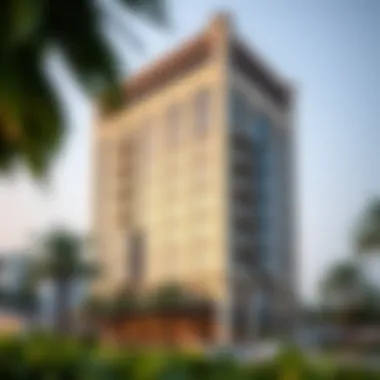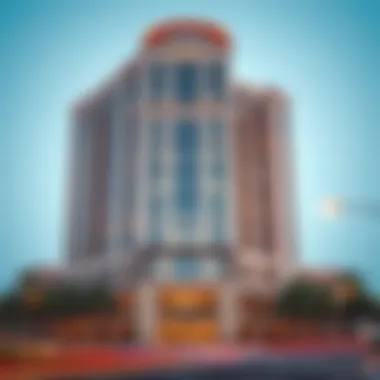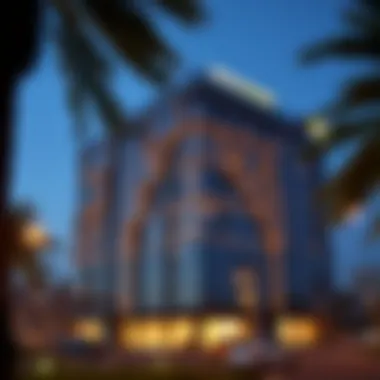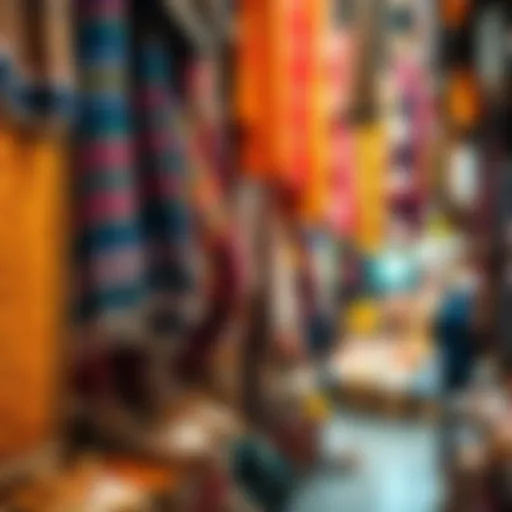The Badri Building: A Key Player in Mankhool's Real Estate


Intro
The Badri Building sits at the heart of Mankhool, a bustling area known for its diversity and rapid development. This structure has become more than just bricks and concrete; it is a symbol of the evolving real estate landscape in Dubai. Understanding its significance requires a closer look at various components — architectural design, investment opportunities, and the vibrant community that surrounds it. As the Dubai property market continues to shift, driven by economic changes and lifestyle preferences, the Badri Building stands out, providing insights both practical and beyond.
Market Trends
Current Real Estate Developments
Mankhool is witnessing a transformation like no other. From high-rise residential towers to quaint community shops, the area is diversifying its offerings. The Badri Building plays a pivotal role in this development narrative, offering both residential and commercial units that cater to a wide range of tenants and buyers.
This surge in construction aligns with the city’s overarching goal of becoming a global hub. Recent projects, such as the nearby City Walk and Dubai Mall expansions, have bolstered the area's appeal, making Mankhool a competitive choice for investors. With more amenities—parks, cafes, and cultural spots—emerging, it’s apparent that Mankhool is not merely keeping up; it's redefining urban living in Dubai.
Impact of Economic Factors on Real Estate Prices
Economic fluctuations have a direct bearing on the real estate landscape, and Mankhool is no exception. Factors such as changes in interest rates significantly affect property values. For instance, when interest rates rise, potential buyers may think twice about making large investments, leading to a cooling off in the real estate market. Conversely, a dip in rates can set off a buying frenzy.
Current trends indicate that the market is likely stabilizing after a period of rapid price increases. Developers and investors are becoming more cautious, analyzing market needs in-depth before committing resources. This careful approach can be a double-edged sword; while it may protect against unsustainable growth, it may also deter potential buyers or investors, causing fluctuations in pricing.
"The thrust toward sustainability in real estate is not just a fad; it’s the future. Properties like the Badri Building are increasingly being evaluated on their ecological footprint, efficiency, and community integration."
Investment Strategies
Tips for First-Time Buyers
Navigating the real estate market can feel like traversing a maze, especially for newcomers. Here are some strategies that can help first-time buyers looking to invest in properties like the Badri Building:
- Do Thorough Research: Knowledge is power in real estate. Familiarize yourself with the area, market trends, and property values.
- Budget Wisely: Don’t just consider the sticker price. Factor in maintenance costs, association fees, and possible renovations.
- Consult Local Experts: Engaging with local real estate agents can provide valuable insights that online resources might miss.
Long-Term vs Short-Term Investment Approaches
When it comes to investment strategies, there’s often a choice between short-term gains and long-term stability. Each approach has its merits, particularly in a dynamic market like Mankhool.
- Long-Term Investment: Buying and holding properties in Mankhool may yield potential appreciation over time. As the area continues to develop, property values are likely to rise. A long-term perspective allows investors to benefit from increased rental demand.
- Short-Term Investment: For those looking for faster returns, considering flipping properties might be an option. However, this requires a keen eye for trends and a readiness to invest time and effort into renovations or marketing.
In today’s real estate climate, with its intricate dynamics, understanding the Badri Building can unlock new pathways for savvy investors seeking to capitalize on the unique opportunities that Mankhool offers.
Ending
The Badri Building is not merely a structure; it forms part of Mankhool's broader real estate narrative, illustrating how architectural design, market trends, and investment strategies intertwine. For both seasoned investors and newcomers, being informed about this locale is vital for making educated choices in Dubai's ever-evolving property market. As stakeholders engage with this landscape, the insights gathered from the Badri Building and its surroundings could very well dictate the direction of future investments.
Prologue to Mankhool and the Badri Building
Mankhool, located in the vibrant heart of Dubai, serves as a crucial component of the city’s broad and ever-evolving real estate landscape. This neighborhood stands out not only for its diverse community and strategic location but also for its rich tapestry of culture and development. The Badri Building, a notable structure within this area, encapsulates much of what makes Mankhool a focal point for both residents and investors alike.
Importance of the Badri Building
Understanding Mankhool and the Badri Building is essential for investors and stakeholders looking to harness the potential of Dubai’s dynamic property market. The Badri Building, with its unique architecture and prime positioning, represents more than just a physical space; it's a canvas illustrating the intersection of tradition and modernity that characterizes the entire area.
This building offers valuable insights into investment opportunities and market trends, making it a case study for those exploring Mankhool.
Overview of Mankhool
Mankhool is a blend of bustling urban life and close-knit community vibes. As part of the larger Bur Dubai district, it is known for its mixed-use properties, ranging from residential apartments to commercial spaces. A few key features stand out:
- Accessibility: Mankhool’s connectivity to the main thoroughfares makes it easy to navigate. The nearby Al-Fahidi Metro Station is a big plus for commuters.
- Cultural Diversity: With an array of nationalities represented, the neighborhood boasts a rich cultural fabric.
- Local Amenities: Shopping centers, schools, and healthcare facilities are within arm's reach, which heightens the appeal for families and professionals.
Mankhool continually evolves while holding on to its roots, making it attractive for homebuyers and renters alike.
Historical Context of the Badri Building
The Badri Building itself carries a legacy deeply intertwined with Mankhool's history. Built in the late 20th century, it marked a time of transformation in Dubai's architectural scene. Designed in a way that reflects both modern needs and traditional aesthetics, it became a landmark.
- Architectural Significance: The structure showcases elements that are typical of mid-century Arabic architecture, infused with contemporary design principles. This brings a unique character to Mankhool.
- Cultural Landmark: Over the years, the Badri Building has become a symbol of the community’s evolution. It has hosted various businesses and initiatives that contribute to local life.
The historical significance of the Badri Building can’t be overstated; it embodies the growth of Mankhool, mirroring the broader advancements happening across Dubai. This building is not just a piece of real estate; it's a story of progress, bridging the past with the future.


Architectural Features of the Badri Building
Understanding the architectural features of the Badri Building is paramount in appreciating its role within the Mankhool landscape. The design encapsulates not just aesthetic appeal, but also functional elements that enhance its significance in the real estate market. The Badri Building stands as a testament to modern architectural practices, incorporating traditional elements that speak to the cultural heritage of Dubai.
Design Elements
The Badri Building's design reflects a blend of contemporary styles with local influences. The façade is striking, with a meticulous layout that engages the passerby. Large windows punctuate the structure, allowing for natural light to flood the interiors. The geometry of the building is captivating, featuring clean lines and a balanced proportion that maintains harmony with its surroundings.
Key design features include:
- Open Spaces: The layout promotes fluid movement between areas, fostering a sense of community.
- Balconies: These exterior extensions offer residents outdoor space, creating a seamless indoor-outdoor connection.
- Landscaping: Thoughtful outdoor design complements the architectural style, providing greenery that softens the building's imposing structure.
This combination encourages interaction among residents and visitors, aligning with the communal spirit of Mankhool.
Materials Used in Construction
When it comes to construction, the choice of materials plays a crucial role in both aesthetics and durability. The Badri Building utilizes a variety of high-quality materials that not only enhance its visual appeal but also ensure longevity. Key materials include:
- Reinforced Concrete: This foundational material is selected for its strength and resilience, essential for high-rise structures.
- Glass Facades: Used generously, these surfaces not just beautify the building but also help in energy efficiency, reducing the need for artificial lighting during the day.
- Stone and Metal Accents: These elements add texture and contrast, making the structure visually compelling.
The careful selection of materials underscores the importance of sustainability and environmental considerations in modern construction, ensuring the Badri Building is both a functional space and a piece of art.
Sustainability in Architecture
Sustainable architecture is not just a trend; it represents a critical shift in how developers and architects approach design. The Badri Building integrates various sustainable practices that are significant for modern developments. Notably, features supporting sustainability include:
- Energy-Efficient Lighting: Utilization of LED fixtures to reduce energy consumption.
- Water-Repurposing Systems: These systems are designed to reduce waste and encourage conservation, essential in an arid climate like Dubai.
- Natural Ventilation: The building design promotes airflow, minimizing reliance on air conditioning, thus lowering energy costs.
Incorporating these sustainable practices not only enhances the building's efficiency but also appeals to the growing demographic of environmentally conscious investors.
Real Estate Market Dynamics in Mankhool
Understanding the real estate market dynamics in Mankhool is critical for anyone looking to make informed decisions in this vibrant locality. Mankhool is not just another region in Dubai; it’s a melting pot of cultural influences and economic activities. Analyzing its real estate market involves looking at several factors, including demand and supply, price fluctuations, and the overall sentiment in the area. From young professionals seeking rental apartments to families looking for their own homes, the diverse needs of various demographics shape market trends significantly.
Current Market Trends
The current real estate market trends in Mankhool illustrate a blend of stability and growth. As more expatriates and locals are drawn to the neighborhood, we see a bolstering demand for both residential and commercial spaces. The rise in population has resulted in an uptick in rental prices, though they vary significantly based on the property’s location and amenities. For instance, units close to the main thoroughfares or featuring modern amenities tend to command higher rents.
- Increase in Luxury Rentals: High-end apartments have seen a rising demand, particularly among expatriates seeking a luxurious lifestyle.
- Sustainability Trends: Buildings that incorporate green technologies are gaining traction, reflecting a global trend generally favored by investors.
"Real estate investment is not just about houses and buildings; it’s about understanding the pulsating heart of the community."
The transformation of Mankhool's landscape, including improved infrastructure and new shopping hubs, only adds to its allure. It's also notable that many investors are looking at these shifts, seeing the potential for long-term capital growth.
Investment Opportunities
When considering investment opportunities in Mankhool, it’s essential to recognize the various sectors where capital can be effectively allocated. The landscape is rich with possibilities:
- Residential Properties: With increasing demand, buying properties for rental purposes can yield significant returns. Investors can target properties that are situated in high-demand areas.
- Commercial Ventures: Mankhool’s commercial sector is ripe for investment. Small businesses, especially cafes and retail shops, are growing, indicating a robust market for commercial real estate.
- Mixed-Use Developments: Investing in properties that combine residential and commercial spaces caters to modern living preferences and can provide diversified income streams.
These avenues present solid potential rewards but understanding the nuances of the local market is paramount for smart decision-making.
Challenges Facing Investors
Despite the promising landscape, investors in Mankhool inevitably face several challenges that require foresight and strategic planning:
- Market Volatility: While the market offers many opportunities, prices can fluctuate based on external economic conditions. Investors must be prepared for potential downturns.
- Regulatory Hurdles: Navigating local regulations regarding property ownership and rentals can be complex, particularly for foreign investors. It’s crucial to stay informed about any changes in the law.
- Competition: The influx of investors and real estate developers can lead to a saturated market. Identifying unique selling points for any property can be essential in standing out from the competition.
In summary, understanding the market dynamics, keeping an eye on current trends, seizing investment opportunities, and being aware of potential challenges can significantly enhance one’s prospects in Mankhool’s ever-evolving real estate sector.
Community Analysis of Mankhool
Understanding the community dynamics in Mankhool is essential for anyone keen on investing in the area. This neighborhood isn't just a dot on the map; it's a living, breathing hub that shapes the real estate landscape. By examining the community's demographic makeup, local amenities, and transportation options, potential investors and homeowners can get a clearer picture of what living or investing in Mankhool truly entails.


Demographic Insights
The demographics of Mankhool reveal a vibrant mixture of cultures and backgrounds. A considerable proportion of residents are expatriates, bringing a rich diversity that enhances the local culture. This melting pot is particularly attractive to investors since it creates a demand for varied housing options and facilities. Furthermore, young professionals are increasingly settling in the area due to its strategic location and affordability compared to other parts of Dubai.
Insights into Mankhool's demographics can be summarized as follows:
- Expats Dominance: Nearly 70% of the population comprises expatriates.
- Age Distribution: A significant number of residents fall within the 25-40 age bracket, representing a group that often seeks rental properties.
- Family Structures: Many families live here, indicating a need for schools and recreational facilities.
Local Amenities and Services
Mankhool stands out for its rich array of amenities and services, making life easier for residents and appealing to potential investors. From shopping centers to educational institutions, the area is well-equipped to cater to the needs of its community.
Highlights of local amenities include:
- Shopping Centers: The presence of various shopping malls, like the Burjuman, offers a blend of retail outlets, dining experiences, and entertainment options.
- Healthcare Facilities: Clinics and hospitals are scattered across Mankhool, ensuring that residents have easy access to healthcare services.
- Educational Institutions: Several schools and nurseries cater to families, which is an appealing factor for those thinking of relocating.
- Recreational Spaces: Parks and fitness centers are available for fitness enthusiasts and families looking to spend quality time outdoors.
These amenities are not just convenient; they significantly contribute to the overall property value and desirability of the area.
Transportation and Accessibility
In real estate, location is king; hence, transportation and accessibility play a crucial role in determining Mankhool's attractiveness to investors. Public transport links, road networks, and the proximity to key areas can heavily influence property decisions.
Key factors include:
- Public Transport Access: Mankhool boasts efficient public transport options, including metro stations and bus services, which facilitate easy commutes to other parts of the city.
- Proximity to Major Hubs: Situated close to Dubai’s central business districts, Mankhool is advantageous for professionals working in downtown areas.
- Traffic Accessibility: The well-connected road networks allow for hassle-free travel both within Mankhool and to neighboring areas.
The unique blend of cultural diversity, excellent local amenities, and transportation links makes Mankhool a prime location for real estate investment.
With all these aspects in mind, Mankhool emerges as not merely a living space but a community that nurtures growth and opportunity, making it an enticing option for investors and home seekers.
For more detailed analyses and studies, you can check out resources like Wikipedia and Britannica.
As investors seek areas ripe for returns, knowing Mankhool's community dynamics can offer the competitive edge needed in today's vibrant real estate market.
Economic Considerations in Mankhool
Understanding the economic landscape of Mankhool is crucial when dissecting its real estate dynamics, particularly as it relates to the Badri Building. The area stands at a crossroads of cultural vibrancy and economic activity, which propels its real estate sector forward. Investors need to consider various economic elements that shape the fabric of this community, ensuring they have a rounded view of the opportunities and challenges within this bustling locale.
Economic Drivers
Economic drivers can be thought of as the engines that fuel growth and development in Mankhool. Some of the most significant drivers include:
- Diverse Commercial Activity: Mankhool benefits from a mix of retail, hospitality, and service industries that create a vibrant economic ecosystem. This includes everything from casual eateries to upscale shopping establishments.
- Proximity to Key Infrastructure: Being close to major roadways and transport hubs enhances accessibility. This is not just beneficial for residents but also for businesses looking to establish a strong presence in the area.
- Foreign Investment: In recent years, Mankhool has seen an uptick in foreign real estate investments, which is a significant indicator of its economic viability. Investors from various backgrounds are eyeing properties, bolstering demand.
- Employment Opportunities: A rising number of businesses leads to more job opportunities. This influx of jobs attracts a workforce that contributes to Mankhool’s economic growth, creating a reciprocal relationship between employment and housing demand.
"Mankhool is like a living tapestry; each thread woven in is a contributor to its economic vitality."
These drivers not only provide a foundation for the local economy but also justify investment decisions related to properties like the Badri Building. If economic activities continue to flourish, it can be expected that real estate values will follow suit.
Impact of Tourism on Real Estate
The impact of tourism on Mankhool’s real estate cannot be overstated. With its rich cultural heritage and pivotal location, the area draws visitors, both for leisure and business. Here are some key aspects worth noting:
- Increased Demand for Short-Term Rentals: The rise of platforms like Airbnb has boosted the short-term rental market, enabling property owners to capitalize on the influx of tourists seeking unique accommodation than traditional hotels.
- Cultural Attraction: Mankhool is home to several historical sites and markets that attract a steady stream of visitors. Properties in proximity to these sites can see an increase in value due to the constant foot traffic.
- Investment in Amenities: To cater to tourists, local businesses often invest in improving amenities and services. This not only beautifies the area but also increases property values, ensuring a profitable landscape for investors.
- Job Creation in Hospitality: The tourism sector creates jobs, enhancing the disposable income of residents, which can lead to higher demand for housing and commercial spaces in the locality.
The relationship between tourism and real estate in Mankhool is a symbiotic one; the former enriches the latter, creating a vibrant area ripe for investment. As more people flock to experience the unique charm of Mankhool, properties like the Badri Building stand to benefit significantly.
Regulatory Framework Affecting Real Estate
The regulatory framework surrounding real estate is a crucial pillar when discussing properties like the Badri Building. An understanding of the laws and regulations governing real estate in Dubai not only shapes the operational landscape but also influences the investment dynamics within Mankhool. For investors, realtors, and analysts, knowing the nitty-gritty of these regulations can either unlock or block opportunities in the market. These regulations ensure that the real estate sector operates in a fair, transparent, and efficient manner, ultimately benefiting both investors and consumers alike.
One of the primary elements of this framework is the Real Estate Regulatory Agency (RERA), which is responsible for regulating and overseeing all real estate activities in Dubai. RERA’s guidelines focus on various aspects, such as property registration, licensing real estate brokers, and protecting the rights of buyers and sellers. Understanding these regulations offers several benefits:


- Enhanced Investor Confidence: Clarity in regulations brings about a level of assurance that investments are safe and well-governed.
- Reduced Risks: Compliance with legal frameworks minimizes the risk of disputes through transparent agreements.
- Market Stability: An effective regulatory environment fosters organic growth in the real estate market, leading to sustainable development.
Navigating through these regulations can indeed be complex, but the rewards often outweigh the hurdles.
Real Estate Regulations in Dubai
Diving into the specific regulations governing real estate in Dubai, several noteworthy aspects come into play that potential investors or stakeholders must keep in mind. The Dubai Land Department (DLD) plays a pivotal role here as well, ensuring all property transactions are recorded and lawful. From the drafting of sales contracts to transactions, the DLD oversees everything with an eagle eye, aiming to protect both buyers and sellers.
In Dubai, the ownership laws differ quite a bit for UAE nationals as opposed to expatriates. Citizens of the UAE can own property anywhere in the emirate without restrictions, while expatriates often face limitations depending on the designated areas for foreign ownership, usually referred to as freehold developments. Also, it’s essential to note that properties in the Dubai Investment Park and Downtown Dubai are among the areas where expats can own titles.
Key Regulations to Note:
- Permit Requirements: All property transactions require appropriate permits, which ensure that the legality of the deal is maintained.
- Fee Structure: Taxes and fees for property transactions need to be well understood, as they can significantly affect profitability.
- Market Norms: Familiarity with local market conditions and regulations comes in handy when making negotiations or offers.
Navigating these regulations could be daunting for newcomers, yet they provide the essential structure necessary for successful property dealings.
Ownership Laws
Ownership laws are at the heart of the real estate framework and play a decisive role in shaping the investment landscape. In Dubai, residential, commercial, and industrial properties all come with their own set of ownership laws.
For expatriates, the ownership laws strictly delineate areas where foreign property ownership is permitted. In some regions, full ownership is allowed, while in hotspot areas, investors may face 90-year leasehold agreements as a compromise. It’s integral for potential buyers to have clarity on these laws before diving headfirst into any deals.
Some important ownership law considerations include:
- Joint Ownership: Many investments are often made in joint ownership or partnership arrangements, especially among foreigners.
- Property Management: Whether owned outright or via leasehold, understanding property management rights is critical for the long-term viability of any investment.
- Inheritance Laws: Investors should also keep in mind that inheritance rules differ significantly. Proper legal advice can safeguard one’s assets and ensure they pass on according to the owner's wishes.
"A thorough grasp of ownership laws can pave the way for smart investment decisions."
In summary, understanding the regulatory framework affecting real estate, along with the unique ownership laws in Dubai, not only presents an ideal backdrop for investment, but also equips investors with the necessary awareness to navigate this intricate landscape confidently. Such insights can empower stakeholders and better position them to make informed real estate decisions in a vibrant and dynamic market.
Future Outlook for the Badri Building
The future outlook for the Badri Building holds considerable significance as both a landmark in Mankhool and a symbol within Dubai's evolving real estate market. As urban dynamics shift, understanding the projected changes surrounding this edifice becomes crucial for various stakeholders, including investors, agencies, and community members. Recognizing potential transformations can help in strategizing upcoming investments and making informed decisions in a competitive environment.
Potential Developments
Anticipated developments around the Badri Building seem promising and merit attention. Local authorities have signaled a push towards enhancing urban infrastructure and improving community amenities. Some potential developments include:
- Enhanced Public Transport: Plans are underway to improve the accessibility of Mankhool through expanded public transportation options, making properties like the Badri Building even more attractive.
- Green Spaces: Initiatives to create parks and open areas in close proximity to the building could enhance the neighborhood’s livability and increase property values.
- Commercial Ventures: New commercial projects could sprout, fostering a blend of residential and business atmospheres. This synergy often attracts a diverse demographic, further boosting the demand for real estate.
- Community Revitalization: There might be local efforts focused on community development, which not only leads to improved facilities but also makes the area more appealing to investors looking for sustainable growth.
These developments can provide a substantial boost to property values in the vicinity, creating lucrative opportunities for both current and prospective investors.
Forecasting Market Changes
As the real estate landscape continually evolves, forecasting market changes is critical, especially regarding the Badri Building. Trends to keep an eye on include:
- Shifts in Buyer Preferences: As more individuals gravitate towards sustainable living solutions, projects that incorporate eco-friendly practices may gain higher traction. Owners might need to adapt their offerings accordingly.
- Changing Demographics: New residents moving in might lead to a shift in market demands, influencing what types of properties—such as commercial versus residential—will be more sought after.
- Technological Disruptions: Innovations in property management and real estate tech can revolutionize how transactions occur. Digital platforms and virtual tours are just a glimpse into how engaging with properties could change.
- Economic Influences: The global economic landscape, particularly in the post-pandemic context, will also play a role. Factors such as interest rates, employment statistics, and foreign investments are pivotal contributors to the local real estate market's health.
"The Badri Building reflects not just structural design but the shifting tides of Mankhool’s living dynamics. Observing these trends today can shape tomorrow’s real estate decisions."
Epilogue
The conclusion serves as a vital component of this analysis, weaving together the various threads that have been explored regarding the Badri Building and its standing within Mankhool's real estate landscape. It’s not merely a wrap-up; rather, it gives us a final chance to reinforce the key insights garnered from each section, allowing both current stakeholders and potential investors to grasp the broader picture surrounding this notable structure.
Summarizing Key Insights
In reflecting upon what has been discussed, several key highlights emerge:
- Architectural Allure: The Badri Building stands out for its unique architectural features, which blend modern elements with cultural significance. This distinct design appeals to both locals and expatriates, offering a sense of place within a rapidly evolving urban landscape.
- Investment Viability: The real estate market in Mankhool is characterized by a robust potential for returns. The demand within the residential and commercial sectors continues to rise, catalyzed by ongoing developments in the area and the overall attractiveness of Dubai as a global hub for business.
- Community Impact: The surrounding community plays a crucial role in the success of the Badri Building. Access to local amenities, cultural sites, and efficient transportation options enhances the living experience and supports tenant retention.
- Regulatory Landscape: Understanding the nuances of Dubai's real estate regulations is key for any investor. The ownership laws and frameworks governing property investments have significant implications for anyone considering the Badri Building as a potential acquisition.
These insights not just highlight the intrinsic value of the Badri Building but also depict the intricate dynamics of Mankhool's real estate market.
Implications for Future Investors
For prospective investors, the importance of this information cannot be overstated. As they navigate the complexities of the market, awareness of the following considerations will be crucial for their success:
- Market Adaptability: Investors should remain adaptable to shifting market conditions. Trends predict that areas like Mankhool will continue to evolve as new developments emerge, offering potential opportunities for those willing to act decisively.
- Long-term Commitment: Real estate is usually a long-game. Comprehending the local culture, community interaction, and infrastructural growth will empower investors to make informed decisions that go beyond quick profits.
- Stakeholder Engagement: Engaging with local communities and key stakeholders can lead to better insights, fostering relationships that may open doors to partnership opportunities or exclusive deals.
- Risk Assessment: Investors must not overlook potential challenges, such as regulatory shifts or market saturation. A thorough risk assessment helps prepare for unforeseen circumstances that might impact the investment’s long-term value.
In summary, the Badri Building is not merely a structure but rather a focal point that encapsulates the vibrant atmosphere of Mankhool, making it an attractive proposition for savvy investors while also contributing to the community’s growth. With the right knowledge and a keen eye for opportunities, navigating this real estate landscape can yield fruitful rewards.















